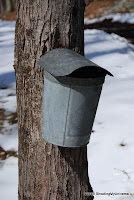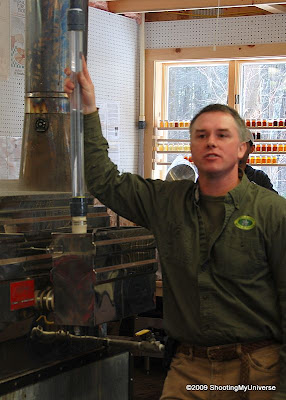

That’s me, on the left, Steve B of SMU and Taster A of Smells Like Grape. That was my friend, Mr. Bussinger in the middle and my brother John on the right. It was the Spring of 1971. Mr. Bussinger has a small sugar bush, about forty taps. Back then pipe lines were a novelty and only the big producers used them. We had galvanized steel buckets, an open arch (fire box) and a three stage pan.
Sugaring involves lots of labor even for a backyard operation like Mr. Bussinger’s. There is wood to split and put in, trees to be tapped, sap to be hauled and hours and hours by the evaporator, feeding the ever-hungry arch. We were out in the weather and one of the things that would keep us warm was drawing off part of the partially boiled sap and having a warm glass. The smell of wood burning and the steam coming off the pan is just heaven. There is nothing else like it.
It has been 35 years since I’ve sugared myself. Time flies by fast with high school activates followed by college, moving to California and then to Colorado and now back to Massachusetts. Something was calling to me this year, my third winter back in New England. Perhaps it was that there was so much snow with no break from the cold much like the winters of my youth in Vermont. Perhaps this awoke old patterns, triggering a need to get back to the sugar bush to smell the arch, taste the sap and just see and hear the drip-drip-drip into a galvanized steel bucket. Perhaps it would give me reassurance that the daffodils will be erupting through the decaying leaves and the tree buds will be coming soon. Perhaps I needed it more this year then ever before.
“B, I found a sugar house in North Andover and they are boiling today. You coming along?” Poor B, she never knows how to plan the weekend. We got into the car and off we went.
Our destination was Turtle Lane Maple Farm. When we arrived, we parked on the street as the website suggested and started walking to the back of the house where the sugar house is located. B wasn’t sure if we were on the right track, but this old woodchuck’s nose knows the smell of burning hardwood and the smell of sap boiling. I was off like a blood hound after a escaped prisoner.
Now I’ve heard rumors over the years of reverse osmosis systems, vacuum evaporators, and other High Tech aproaches to production. I have to set my purist, sentiment behind. Sugaring is energy intensive, even if it is a wood fired operation such as Turtle Lane. Using an RO system dramatically reduces the water content and shortens the evaporation time with less impact on the environment, and as long as the product is the same, I shouldn’t care. 
The heart of the sugar house is the arch and the evaporator. The arch is a horrid task master, needing to be feed every ten minutes. The evaporator is monitored for temperature and sap level. The temperature of the sap is an indication of sugar content and as it reaches the sugar content of syrup, the temperature and density are closely monitored and when the conditions are right, it is drawn off to be finished under conditions that can be precisely monitored.
The value of Turtle Lane Maple Farm isn’t just the fine syrup products, but they are oriented towards education. Paul and Kathy open their sugar house to the public and provide informative talks sparing no detail about the history and technology of sugaring. We were very pleased to visit their sugar house on the first boiling day. I would imagine the syrup produced today will be “fancy” grade.
Sugaring will run all through March. Sap runs when the nights are cold and the days are warm. By April, the nights will be too warm for the sap to run. Until then, check the Turtle Lane website for their boiling schedule. If you are not near North Andover, you can do a search for “maple syrup, [state]” and you will find a link to that state’s maple producer’s association. This will help you find a sugar house to visit. Please do. There is so much to learn as this old Vermonter is happy to attest. If nothing else, you must smell this wonderful steam coming off of the evaporator!
Saturday, March 7, 2009
Maple Sugar
Subscribe to:
Post Comments (Atom)










8 comments:
Wow! What a fabulous post!! Very interesting. My aunt and uncle have a get-away cabin and property in Brown County, Ohio, and they tap their maples every year and make syrup in a "sugar shack" they built. Love seeing all the photos of the process...old and new!
Well, while the picture dated 1971 showed no snow on the ground, I remember years when we were waist deep in snow. And would you not know it from this picture, but the tree that produced the most sap was the one furthest away! But we got that one first as that one usually took 2 trips. Yes, Mr. Bussinger was a great person who not only boiled sap in the spring, but was a blacksmith and created mechanical wonders for the local trades folks. But that is way off topic. I agree that the scent of boiling sap to a New Englander (or elsewhere) is addictive. If you smell the sweet aroma, you have to investigate, enjoy the local conversations, learn the techniques and yes, try to boil it yourself. Yes we too had a small wood stove out back and yes we did tap trees and boil the sap. We only produced 2 gallons at best, but we did have fun! Yes the technology of boiling sap has come a long way from the simple pan, to a 3 channel evaporator, to reverse osmosis. From galvanized buckets to pipe lines. To Vermonters, the Maple Syrup sales are like Sweet Gold. It does take a lot of time and effort to make 1 gallon of syrup and I do encourage everyone to enjoy the local art of this yearly event. It sometimes last 3 or 4 weeks, sometimes more and sometimes less. It’s up to Mother Nature and the seasonal change.
Great post Steve and B… And B, we hope you enjoyed the trip and tour of this local gathering of friends and nature. Kind of scary at first, but y'all will go back for the sweet necture.
Hi Kelly, I've heard of folks tapping trees in Ohio. It makes sense. I've often wondered why it hasn't caught on in other parts of the world. I used to look at my silver maple in the back yard of the postage stamp lot I owned in North Denver and thought, hey if I hang a couple of buckets on that, I might get a pint of syrup...
Hi John, Thanks for the addition. I miss the old guy.
It was fun, and kind of exciting to be there on the first boiling day of the season. But, I told Steve next time we have to find one that's been boiling for a week so they might have some fresh syrup bottled for us to buy!
Well I've learnt one hell of a lot. Thanks Steve.
Great post with a little New England education. I agree, i love the smell of the boiling sap. My cousin has a sugar house, unfortunately he passed away, but I understand his wife still has locals come in and make the maple syrup. Last time I was at his house we had his maple syrup on vanilla ice cream for dessert, yum!! Thanks for the post, Steve
Hi Cindy, I used to put maple syrup on ice cream too! I was much younger then and could handle the sugar rush! I love the smell of sugaring. Today, I visited a sugar house in Chester, NH...just to smell the sap boiling!
Cool Frank, thanks for reading through the post.
For all visiting from SMU, That is B up above The Early Birder. For those reading comments, many sugar producers will discount last year's crop. Don't worry or stress. Maple Syrup will last for years on the shelf, unopened. Last year's crop is okay, I generally don't even ask.
Post a Comment